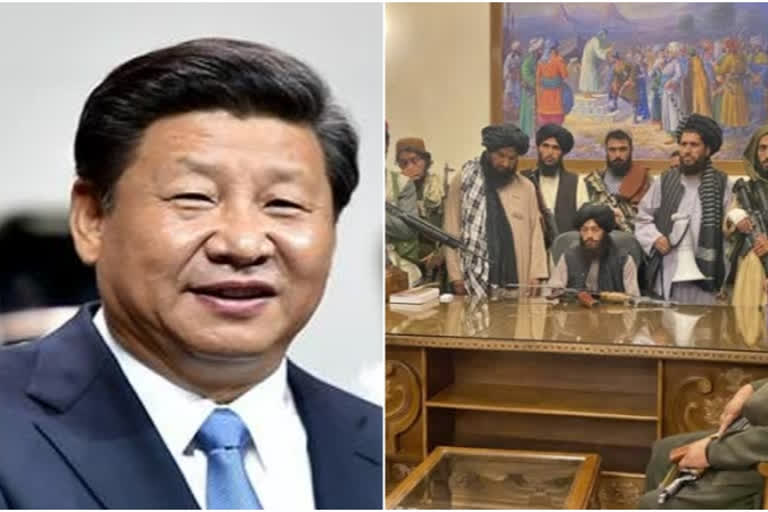Hyderabad: Amid the Taliban's takeover in Afghanistan, eyes are keen on East Asian country China. The US troops withdrawal from war-ravaged Afghanistan after 20 years has ended up in escalated tensions in the country. Meanwhile, China's policy, strategy and worldview vis-à-vis the Taliban, Afghanistan and the wider Islamic world has gained momentum.
China's tryst with Taliban between 1996 and 2001
Being the country's neighbour, China has been enduring decades-long relationships with Afghanistan. China shares Afghanistan's border along the end of Wakhan Corridor in the northwest of the Chinese autonomous province of Xinjiang. Accordingly, Beijing has been keen on preventing conflict in Afghanistan.'
Tracing back the era of Soviet occupation, the People’s Liberation Army (PLA) provided support in terms of training, arms, military advisors and finances to the Mujahideen resistance alongside the Central Intelligence Agency (CIA). Several thousands of these mujahideen militants were trained in camps inside Xinjiang. China's high-grade military equipment including machine guns and surface-to-air missiles worth up to US $ 400 million outshined mujahideen camps.
While the Afghan mujahideen formed the Taliban in the early 1990s, China shared a rapport with the group already. During the Taliban's rule in 1996, Beijing maintained low-level engagement with the group through diplomacy, ensuring safety and stability at its border. Reports suggested that the Talian was extended support from Beijing after the US' cruise missile attack on Afghani militant bases. They reportedly provided access to a missile computer guidance system.
As the Taliban's strongholds in the country bolstered, Beijing signed a military pact to train Afghan pilots in 1998 as well as signed economic cooperation agreement in 1999. Meanwhile, China's ties with the Taliban is attributed to the belief that better relations with the group would curb illicit activity including terrorism and drug trafficking. Further, the bilateral ties would deter the Taliban from supporting Uyghur Muslim rebels in Xinjiang—which China considered a major internal security threat.
Following the end of the Cold War and the disintegration of the Soviet Union, the Xinjiang province shared borders with eight states out of which five were Islamic. It made Beijing wary of the support they could provide to Muslim or Islamic rebellion within Xinjiang.
Reiterating China's goal to deter the Taliban from supporting Uyghurs in Afghanistan and East Turkestan Islamic Movement (ETIM), Beijing ventured to set up an embassy in Kabul and meet the Taliban's head Mullah Omar in 2008. The Taliban turned the table for formal recognition of their government and prevention of sanctions against the regime. However, the deal turned futile as the Taliban refused to oust ETIM and Beijing refused to block sanctions.
China lashed back with an anti-Islamic-fundamentalist alliance” with Central Asian states—Russia, Kazakhstan, Kyrgyzstan and Tajikistan—to “isolate the Islamic revolt in Xinjiang and prevent movement of Muslim rebels across the region’s borders”.
The Taliban took over Kabul in 1996, on the other hand, the Sino-Central Asian alliance evolved as the “Shanghai Five”, aimed at securing their borders, controlling religious extremist forces and building confidence between Beijing and the former Soviet satellite states. In 2001, China led the path towards this alliance’s formal institutionalization as the Shanghai Cooperation Organisation (SCO). Gradually, China operated through the SCO to maximise its economic and security interests in Afghanistan.
Also read:Is the famed resistance of Panjshir Valley becoming history?
Pragmatic hedging strategy post 9/11
The 9/11 terrorist attack against the United States brought a twist to China's relation with the Taliban. Beijing’s formal Taliban engagement and hedging strategy turned no more sustainable. China outwardly supported the US war on terror, on the other hand, informal, clandestine links continued with the Taliban through Pakistan. These links were principally aimed to serve Chinese economic interests in the region as well as maintaining stability in Xinjiang.
Reports suggested that the Taliban may have received Chinese-made weapons via Iran, while analysts raised suspicions that the Haqqani-led group had intentionally kept attacks away from Chinese infrastructure projects (like the MesAynak copper mine outside Kabul, in which China invested US$ 3 billion in 2007 under a 30-year lease agreement). Such a pragmatic hedging strategy put light on China’s broader approach of balance towards the West Asia/Middle East, where it has sought to build somewhat equi-cordial ties with all states.
However, developments in the last few years led to the emergence of Beijing as a critical role player in Afghanistan's future. China–Taliban summits in 2018 and 2019 witnessed bolstering associations between both the countries, as the Trump administration negotiated a peace deal with the Taliban. Notably, the nine-member Taliban delegation travelled to China to seek Beijing’s advice on Trump’s proposed deal for a peace framework—demonstrating China’s considerable influence over the Islamist group.
Xi Jinping’s dreamt of “national rejuvenation” of the Chinese kingdom. Beijing embarked on a grand strategy that sought to firmly establish China as a global great power. It thus undertook not only expanded economic engagement and developmental aid lending, but also an expansion of security interests to protect such investments. This further extended China’s geo-political clout. Deepening engagement with Afghanistan came under such a strategic calculus, albeit with a degree of pragmatism.
